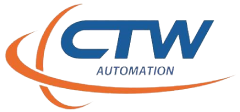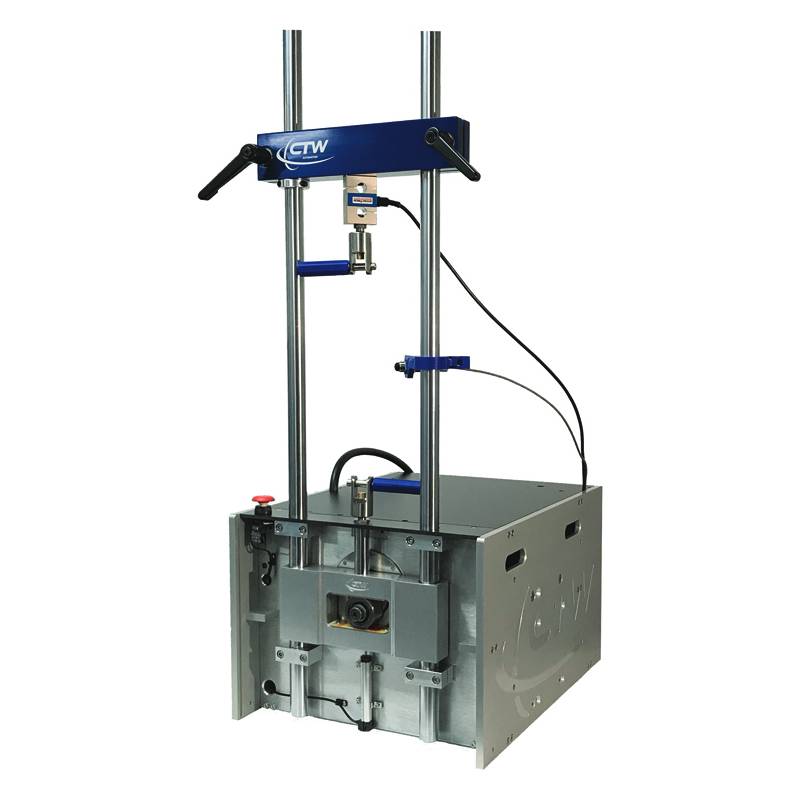CTW RD design improvements over the Roehrig-VS tabletop shock dyno
In designing our RD, rotational “shock” dyno, we took the many years of experience we have and improved where we felt needed. Based on user feedback and service issues, we built our shock dynos to go to the next level over the Roehrig design. While we still maintain the simple driveline we fixed and updated weak points of the Roehrig machines.
Pictured: RD2 / RD3 shock dyno
Here are 12 examples of improvements we designed into the CTW designed shock dynos.
- Front vertical plate is thicker for low bleed dampers – strength
This supports the crank bearing for the high loads encountered with “zero” or low-bleed rebound dampers. - Yoke is stiffer – less deflection / hysteresis in graphs
Again, we knew this was an issue and we designed accordingly. Any deflection will be seen in the data in various ways including “lag” or hysteresis. - Yoke bearing guides based on a 4-point system to provide long term linear motion
Roehrig yoke used 3-points and was able to rock side-to-side over time. - Displacement on centerline to avoid excess motion from off axis sensors
Roehrig system had outboard sensors that are not on the centerline of actuation. Any mechanical play will be seen in the data as the sensors can tend to “rock” as a result of being mounted off centerline. - Slightly narrower columns – makes crossbar stiffer for less deflection.
Deflection in any part of the system means the true damper measurements are compromised. - Smaller diameter columns – lighter and better sized for actual loading.
Keep in mind, Roehrig 20VS (20HP) machines used the same size columns as the 2VS (2HP). Something was not designed correctly. - Front cover removes quickly for stroke changes – simply slides up and off
No more button heads to remove, lose, drop, etc. - Less exposed connections
With inboard electrical connections, no exposed electronics. - Easily visible light for “power-on” indication
Neat, small light on front of the machine. - Side plates designed to protect displacement sensors from damage when moving
Our side plates extend forward of the sensor so that you cannot damage it when moving. Roehrig dynos, when moved, could easily damage, and bend the velocity and displacement sensors as well as the front and rear covers. - No velocity sensor
Many Roehrig designs were limited on velocity due to the velocity sensor’s range. - Quick release crossbar stop as well as spring loaded IR-temperature sensor mount.
This was a customer request, early on, and it saves time and effort.
Current dealers for CTW Products
Australia
Performance Wholesale Australia
6 Cronulla Court
Slacks Creek, QLD 4127
Ph: +61 7 38081986
Email: sales@pwa-au.com.au
Website: www.performancewholesale.com.au
2 Cronulla Court
Slacks Creek, QLD 4127
Ph: +61 7 38084333
Email: qss@pwa-qss.com
Website: www.speedwayspares.com.au
China
深圳市力耐格科技有限公司
Shenzhen Lynag Technology Co., Ltd
A110, 92 Fukang Road
Henggang community, Longgang District
Shenzhen 518115, China
Web: www.lynag.com

Japan
224-1 Haneo, Odawara
Kanagawa 256-0804 Japan
Contact sales: Shingo Sobu
Ph: +81-465-46-7408
Email: info@enable-apg.jp
Website: www.enable-apg.jp


